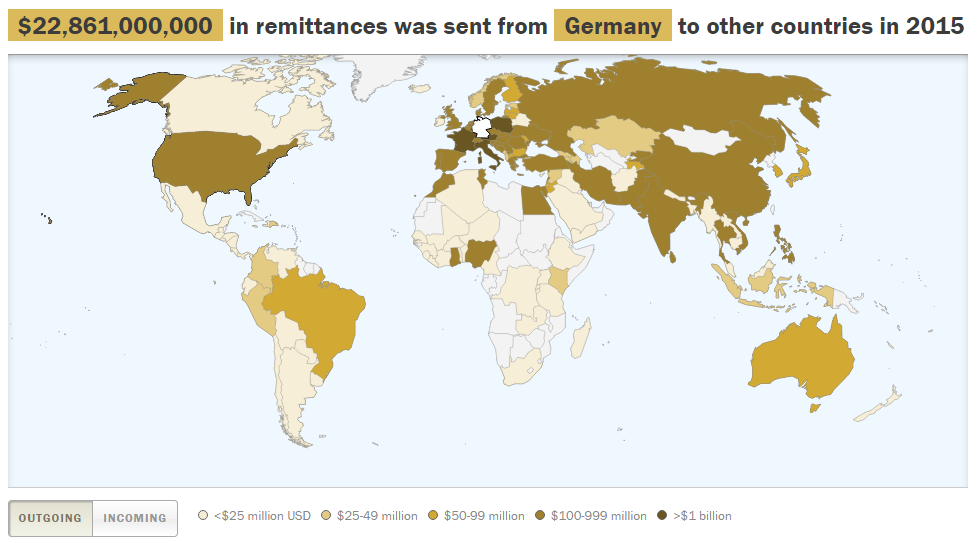Migrants sent half a trillion dollars home last year. These maps show where the money went

For a growing number of families, remittances is their main source of income
Image: REUTERS/Rick Scuteri
Stay up to date:
Migration
There are now 244 million people living in a country other than the one they were born in, according to migration figures from the United Nations.
Many of those people went overseas to find work, leaving their families behind. For a growing number of families, the money their relatives send home, known as remittances, is their main source of income. The chart below shows the growth in remittances between 1990 and 2015.

Remittances in 2015 totalled an estimated $582 billion according to World Bank figures. The Pew Research Center has used the same figures to create an interactive map which tracks the huge amounts of money flowing between developed and developing countries.
The United States is home to 19% of the world’s migrants. They sent $133.5 billion in remittances in 2015.
The biggest recipients were: Mexico, $24.3 billion; China, $16.2 billion; and India, $10 billion.

Germany has the second highest number of migrants. In 2015 migrants sent home $22.8 billion from Germany, mainly to neighbouring European countries.
The biggest recipients were: Poland, $2.1 billion; France, $1.9 billion; and Italy, $1.3 billion.

Saudi Arabia is home to migrants from very different backgrounds. Thousands of highly educated staff from Western nations are employed in the energy sector. A much higher number of migrants from the developing world work in low-paid domestic jobs and in the construction industry. Between them, they sent home $45.7 billion in 2015.
The biggest recipients were: Lebanon, $1.4 billion; Myanmar, $954 million; and Syria, $474 million.

______________________________________________
Have you read?
How can Europe help migrants send money home?
Do remittances really help at home?
How women manage Mexico’s remittances
______________________________________________
Remittances have a huge impact in the countries that receive them. World Bank figures show that in 2015, remittances to Egypt were worth four times as much as revenues from the Suez Canal. In Nepal they make up nearly one-third of total GDP.
Much of the money migrants send home is spent on food and immediate household needs. But there is evidence to show that many recipients are using the money to ensure a more secure and healthier future for their families.

The current mass movement of people is one of the defining challenges facing world leaders. The UN is now formulating a longer term plan to make sure the remittances these migrants send home in the future will have maximum benefit for their families. Under the 2030 Agenda for Sustainable Development, the UN is calling for the transaction costs of remittances to be reduced.
Accept our marketing cookies to access this content.
These cookies are currently disabled in your browser.
Don't miss any update on this topic
Create a free account and access your personalized content collection with our latest publications and analyses.
License and Republishing
World Economic Forum articles may be republished in accordance with the Creative Commons Attribution-NonCommercial-NoDerivatives 4.0 International Public License, and in accordance with our Terms of Use.
The views expressed in this article are those of the author alone and not the World Economic Forum.
Related topics:
Forum Stories newsletter
Bringing you weekly curated insights and analysis on the global issues that matter.
More on Financial and Monetary SystemsSee all
Sandeep Bhattacharya and Sourajit Aiyer
June 22, 2025
Sandy Kaul
June 19, 2025
Poman LO and Luis Alvarado
June 19, 2025
Annette Mosman
June 19, 2025
Stacie Calder
June 16, 2025




